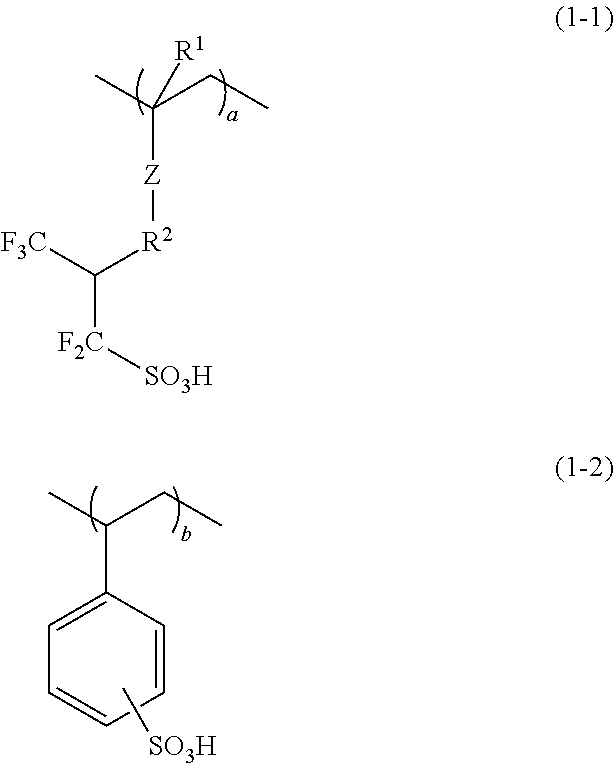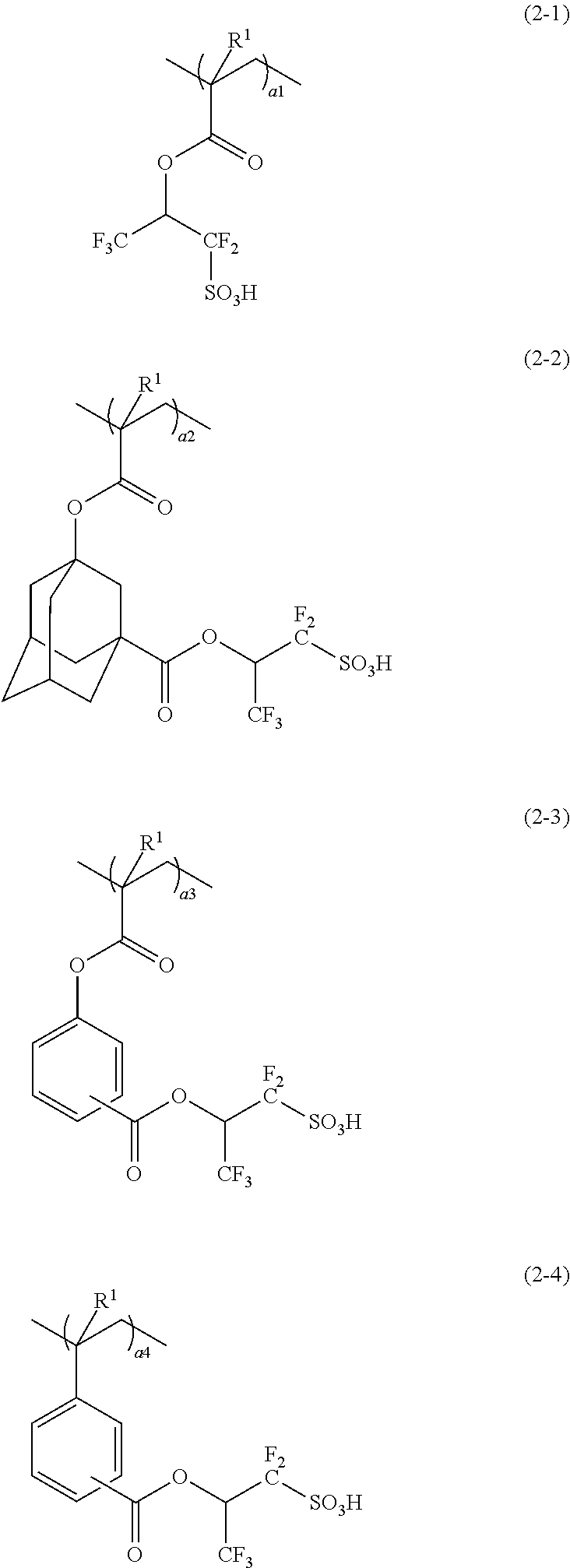Polymer compound
a polymer compound and compound technology, applied in the field of new polymer compound, can solve the problems of glass transition point, heat flow, conductivity drop, etc., and achieve the effects of high conductivity, high transparency, and high durability
- Summary
- Abstract
- Description
- Claims
- Application Information
AI Technical Summary
Benefits of technology
Problems solved by technology
Method used
Image
Examples
example 1
[0073]Under nitrogen atmosphere, to 37.5 g of methanol stirred at 64° C. was added dropwise a solution in which 30.9 g of Monomer 1, 19.1 g of styrene sulfonic acid, and 4.77 g of dimethyl 2,2′-azobis(isobutyrate) had been dissolved in 112.5 g of methanol over 4 hours. The mixture was further stirred at 64° C. for 4 hours. After cooling the mixture to room temperature, the mixture was added dropwise to 1,000 g of ethyl acetate under vigorous stirring. The formed solid material was collected by filtration, and vacuum dried at 50° C. for 15 hours to obtain 42.5 g of a white polymer.
[0074]When the obtained polymer was measured by 19F-NMR, 1H-NMR, and GPC, the following analytical results could be obtained.
[0075]Copolymer composition ratio (molar ratio)[0076]Monomer 1:styrene sulfonic acid=1:1
[0077]Weight average molecular weight (Mw)=29,900
[0078]Molecular weight distribution (Mw / Mn)=1.91
[0079]This polymer compound is made Polymer 1.
example 2
[0080]Under nitrogen atmosphere, to 37.5 g of methanol stirred at 64° C. was added dropwise a solution in which 20.3 g of Monomer 2, 29.7 g of styrene sulfonic acid lithium, and 5.13 g of dimethyl 2,2′-azobis(isobutyrate) had been dissolved in 112.5 g of methanol over 4 hours. The mixture was further stirred at 64° C. for 4 hours. After cooling the mixture to room temperature, the mixture was added dropwise to 1,000 g of ethyl acetate under vigorous stirring. The formed solid material was collected by filtration, and vacuum dried at 50° C. for 15 hours to obtain 48.0 g of a white polymer.
[0081]The obtained white polymer was dissolved in 912 g of pure water, and the lithium salt was converted into a sulfo group by using an ion exchange resin. When the obtained polymer was measured by 19F-NMR, 1H-NMR, and GPC, the following analytical results could be obtained.
[0082]Copolymer composition ratio (molar ratio)[0083]Monomer 2; styrene sulfonic acid=3:7
[0084]Weight average molecular weight...
example 3
[0087]Under nitrogen atmosphere, to 37.5 g of methanol stirred at 64° C. was added dropwise a solution in which 39.0 g of Monomer 3, 11.0 g of styrene sulfonic acid lithium, and 3.34 g of dimethyl 2,2′-azobis(isobutyrate) had been dissolved in 112.5 g of methanol over 4 hours. The mixture was further stirred at 64° C. for 4 hours. After cooling the mixture to room temperature, the mixture was added dropwise to 1,000 g of ethyl acetate under vigorous stirring. The formed solid material was collected by filtration, and vacuum dried at 50° C. for 15 hours to obtain 46.0 g of a white polymer.
[0088]The obtained white polymer was dissolved in 414 g of methanol, and the ammonium salt and the lithium salt were converted into sulfo groups by using an ion exchange resin. When the obtained polymer was measured by 19F-NMR, 1H-NMR, and GPC, the following analytical results could be obtained.
[0089]Copolymer composition ratio (molar ratio)[0090]Monomer 3; styrene sulfonic acid=3:2
[0091]Weight aver...
PUM
| Property | Measurement | Unit |
|---|---|---|
| Electrical conductor | aaaaa | aaaaa |
Abstract
Description
Claims
Application Information
 Login to View More
Login to View More - R&D
- Intellectual Property
- Life Sciences
- Materials
- Tech Scout
- Unparalleled Data Quality
- Higher Quality Content
- 60% Fewer Hallucinations
Browse by: Latest US Patents, China's latest patents, Technical Efficacy Thesaurus, Application Domain, Technology Topic, Popular Technical Reports.
© 2025 PatSnap. All rights reserved.Legal|Privacy policy|Modern Slavery Act Transparency Statement|Sitemap|About US| Contact US: help@patsnap.com



